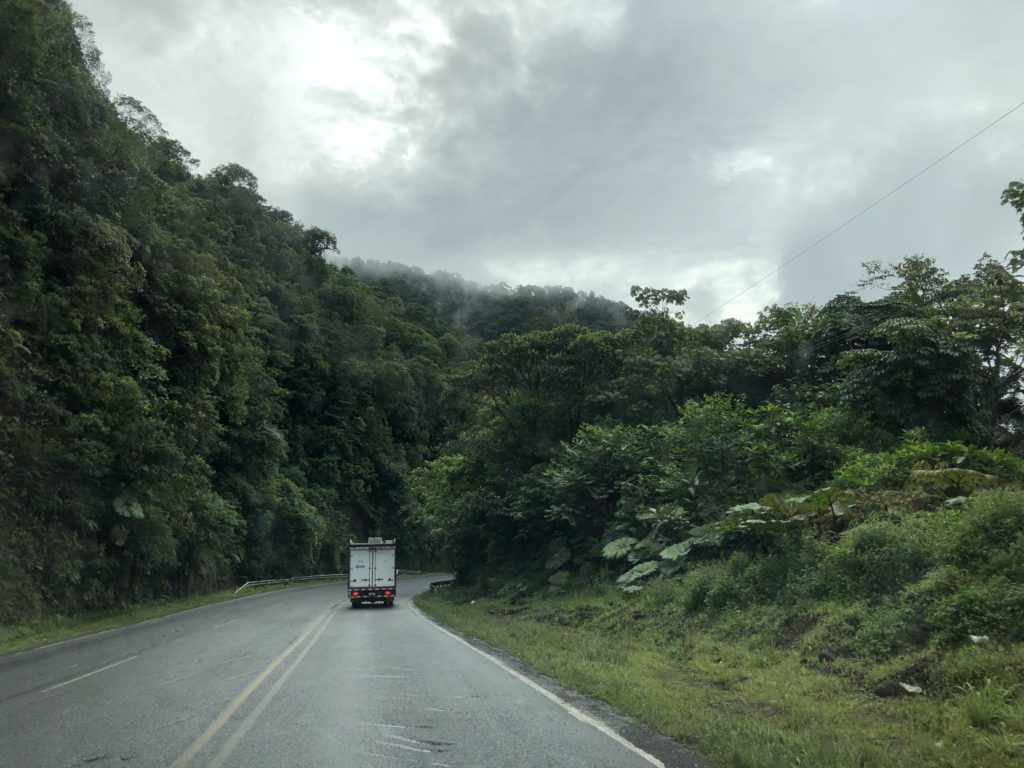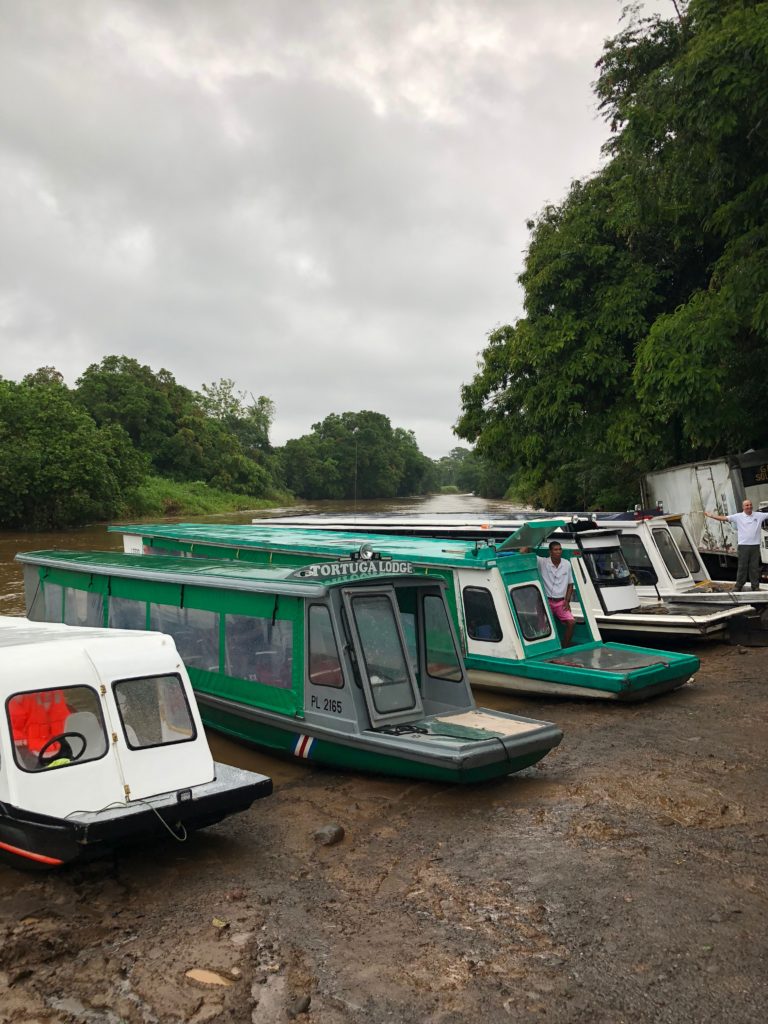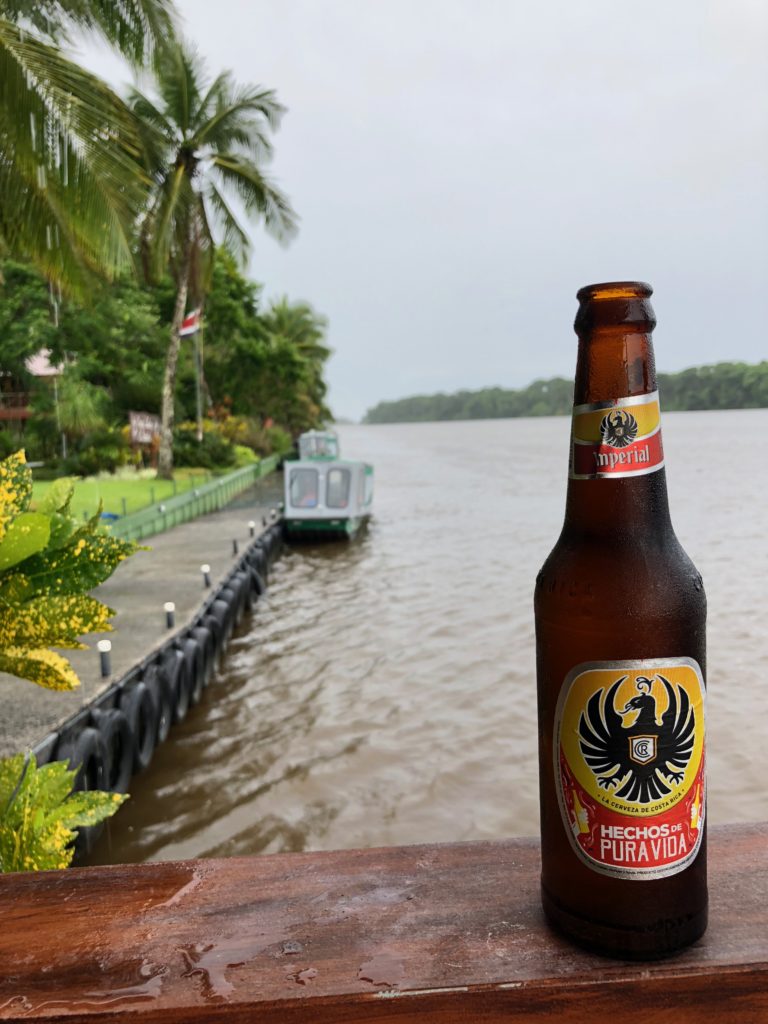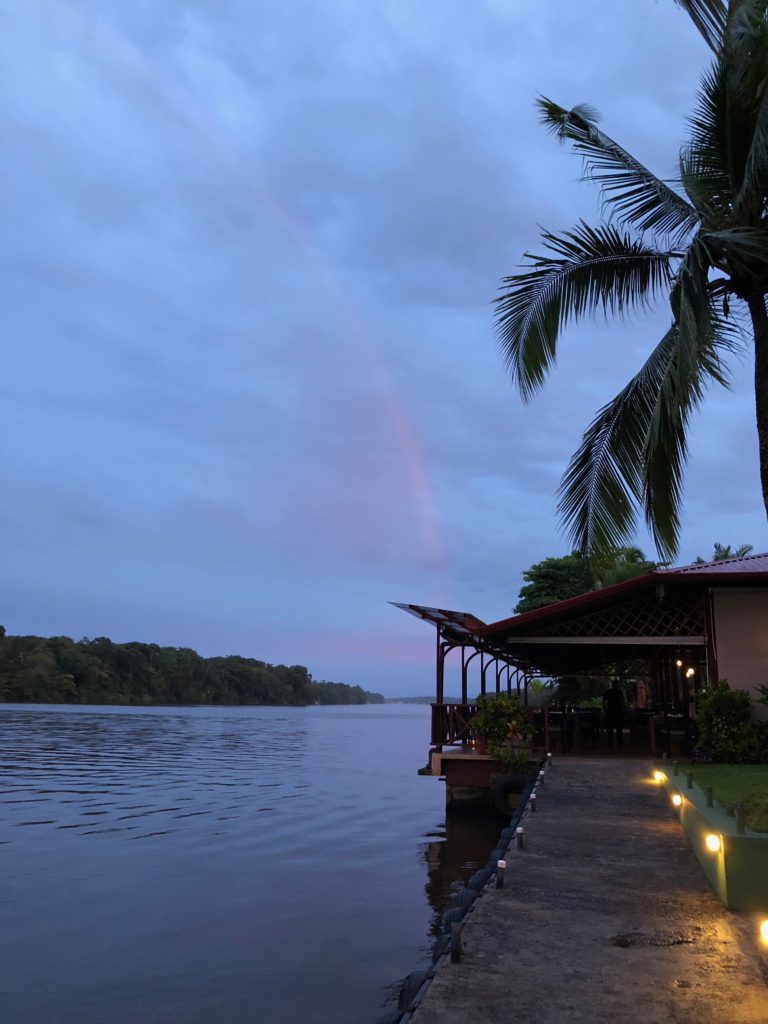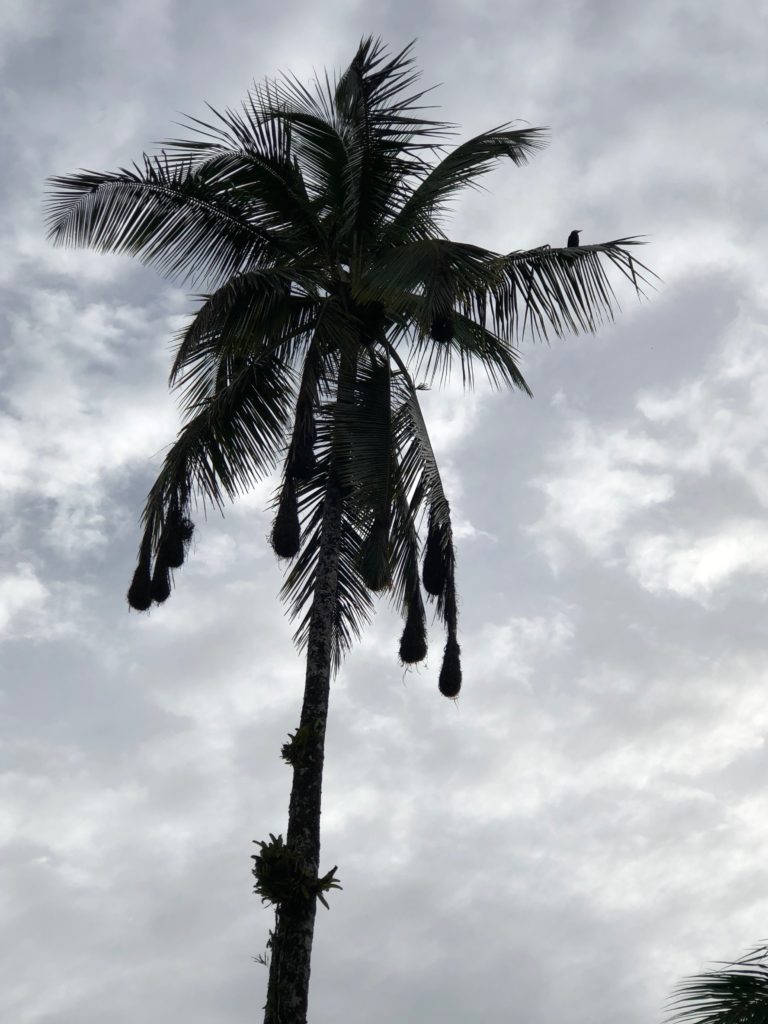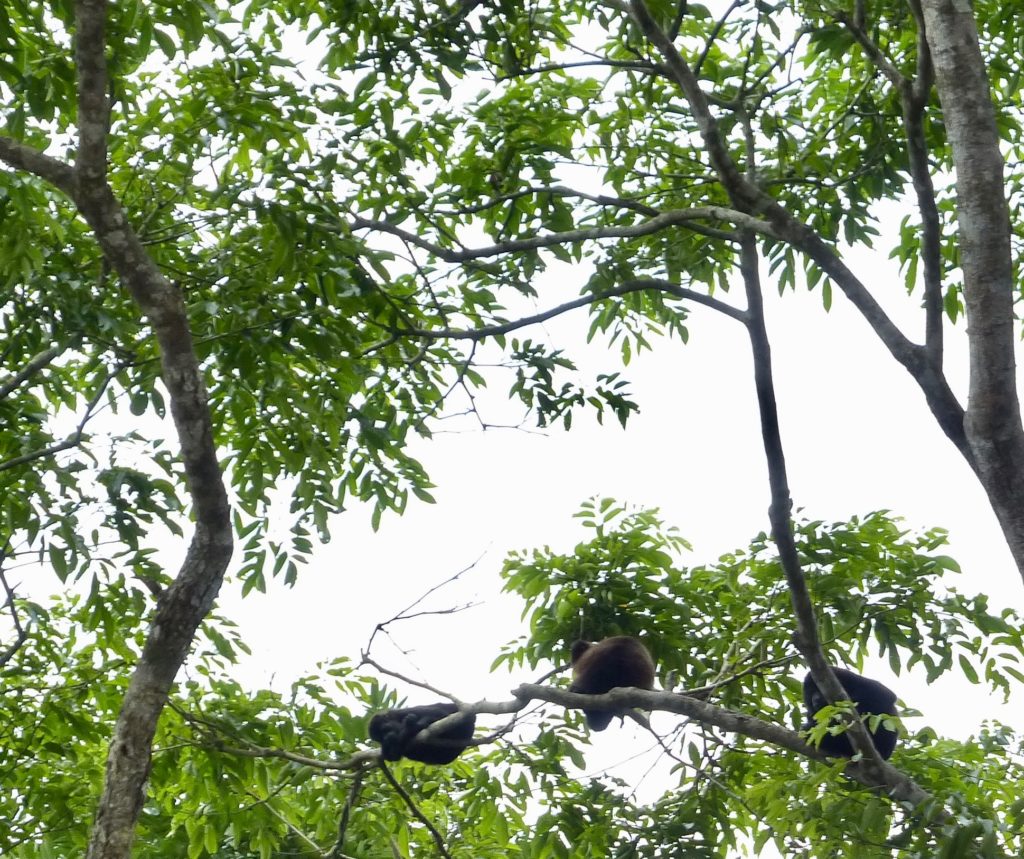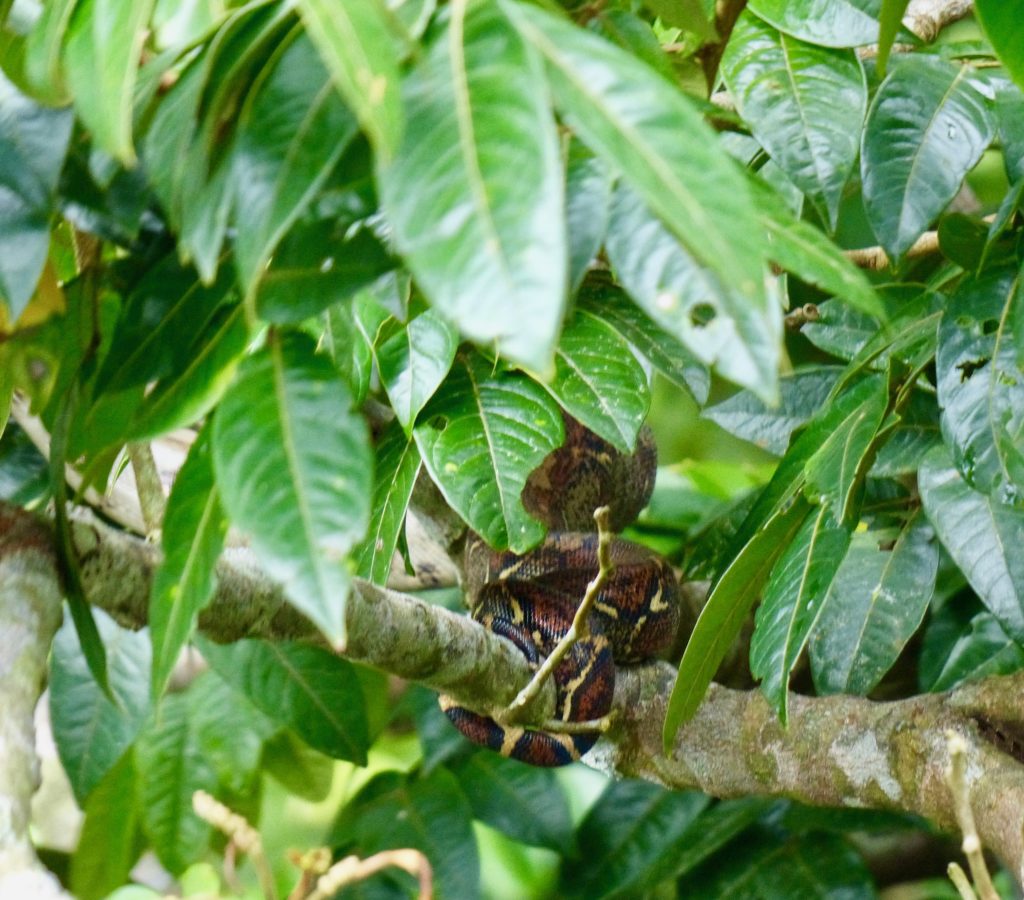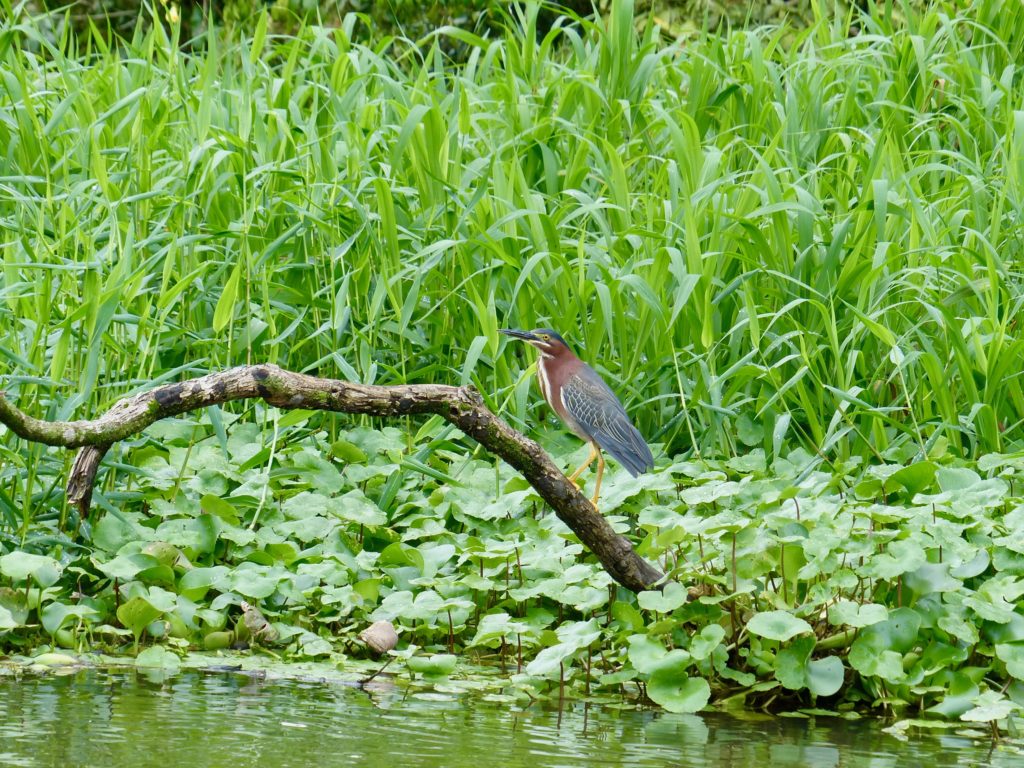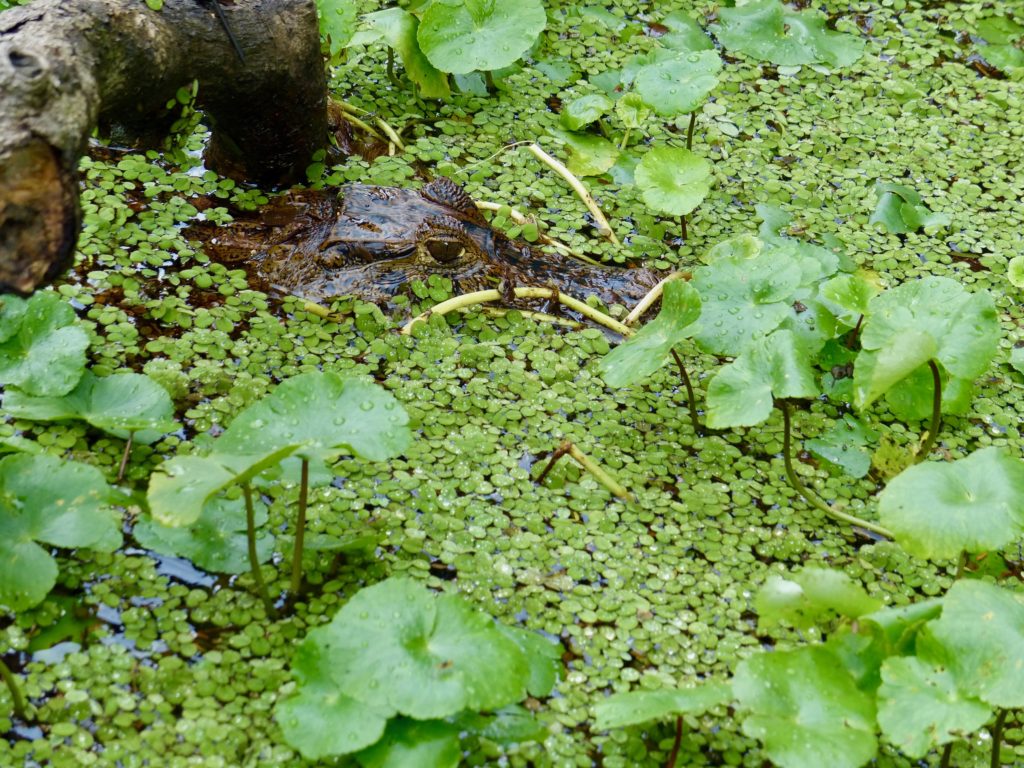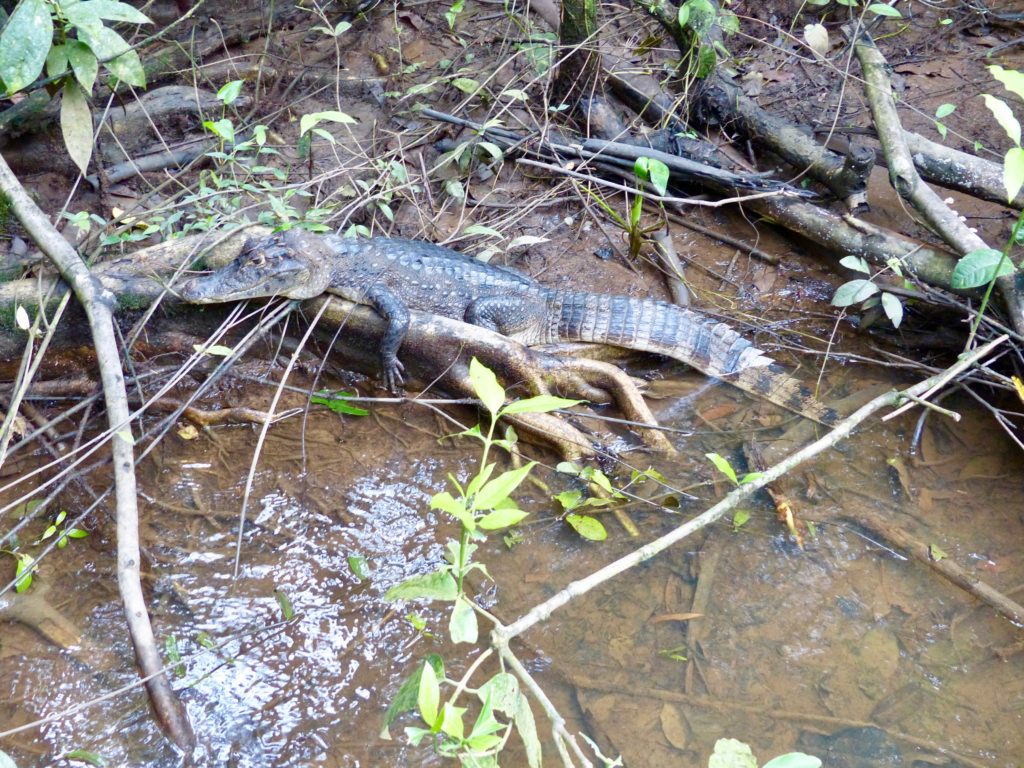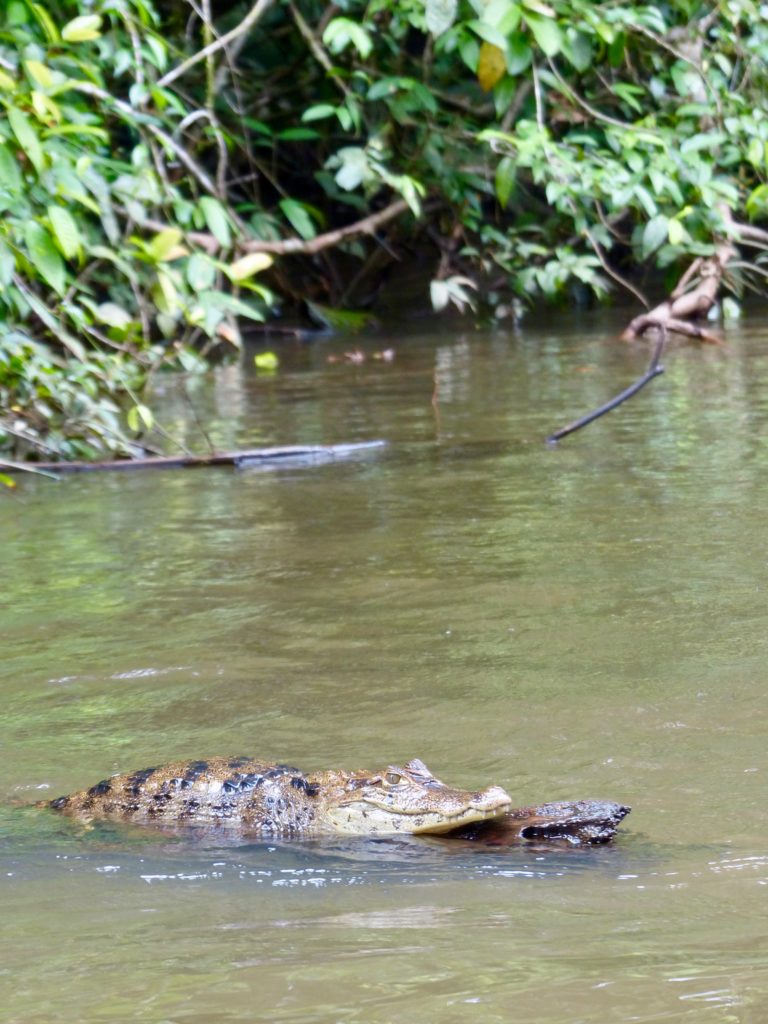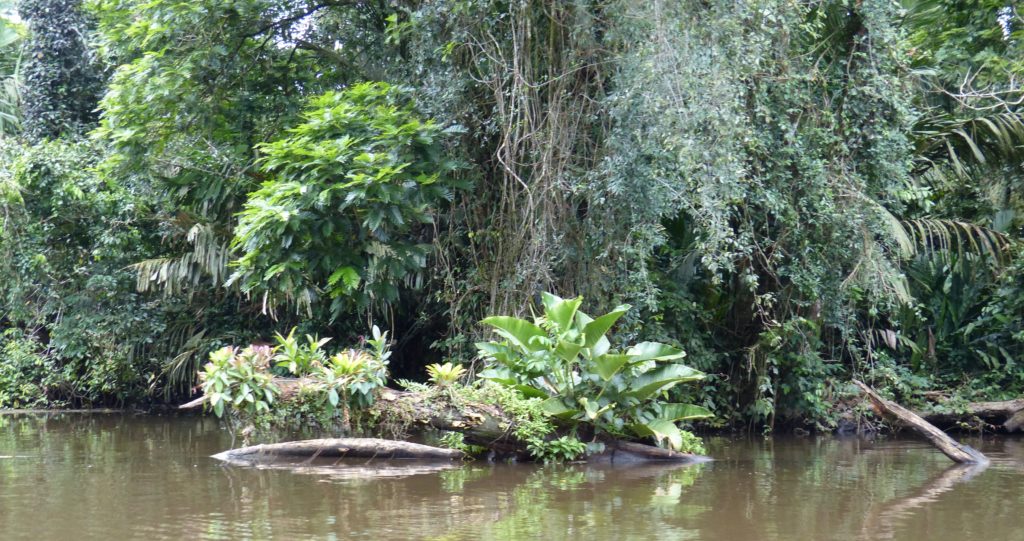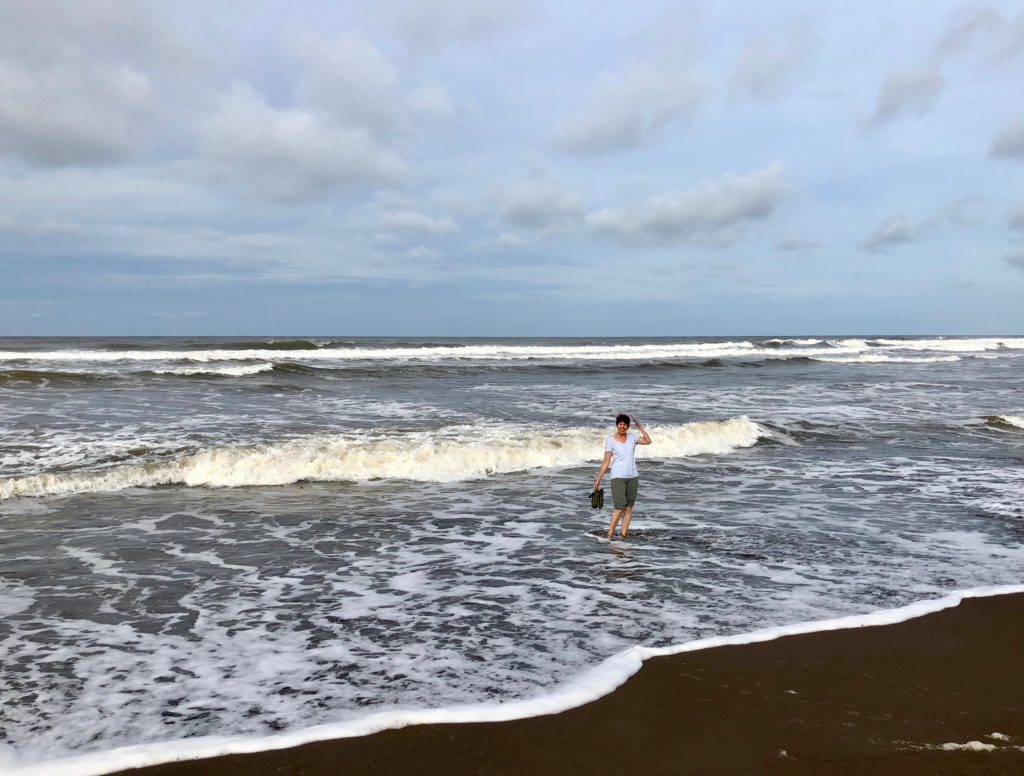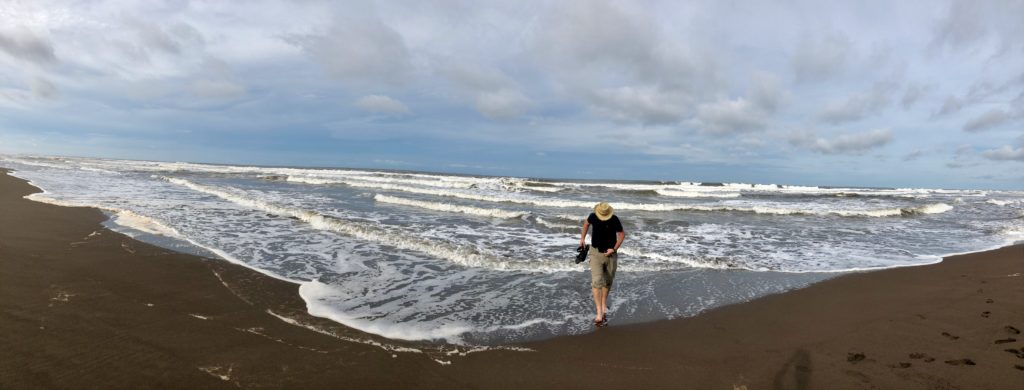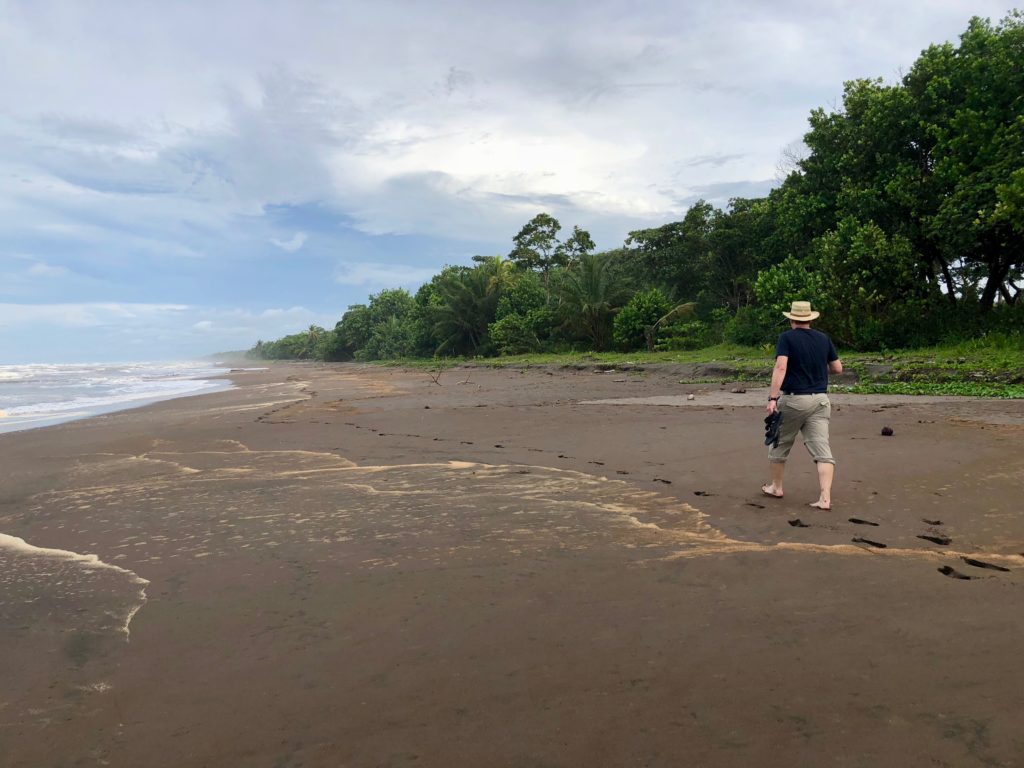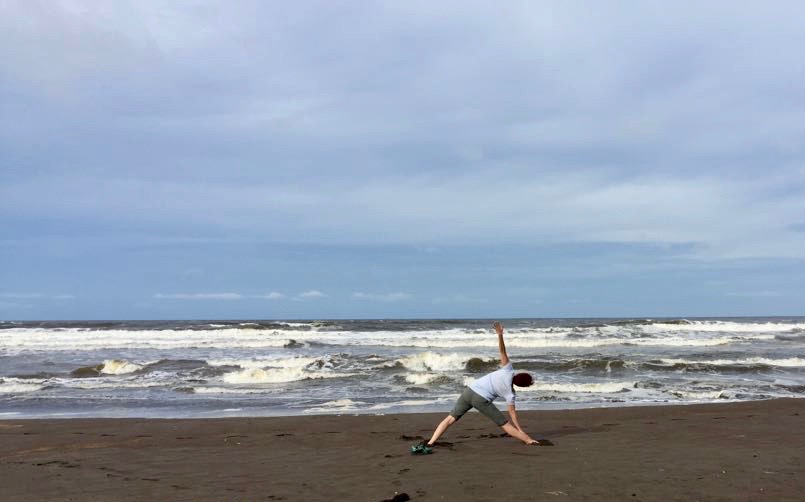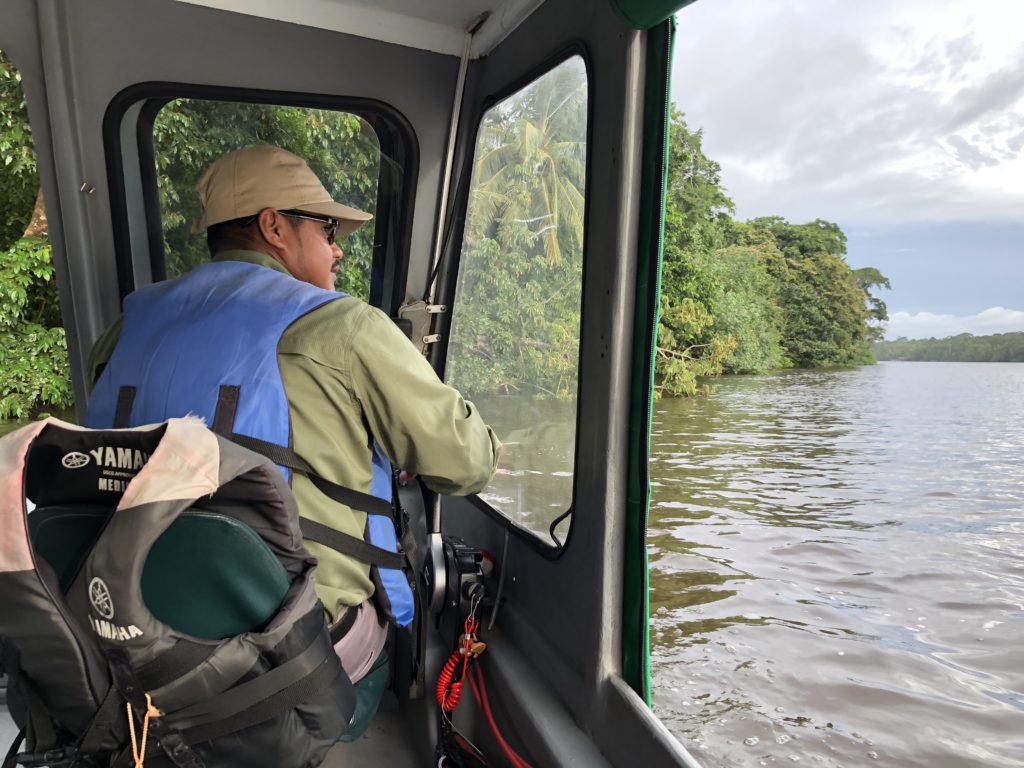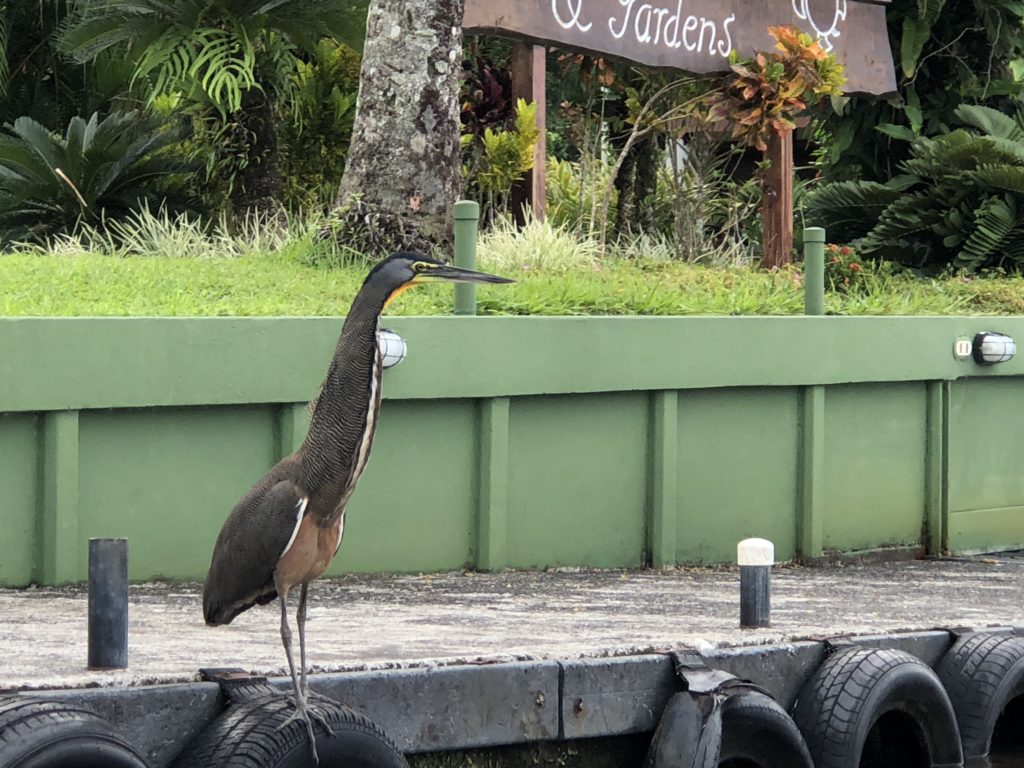Although our airline debacle had sucked away a whole day of our vacation, Tony and I were ready to kick it into gear. We spent the night in San Jose (with our luggage and our rental car!) and got up early to drive to the Caribbean coast. Two quick notes: The traditional Costa Rican breakfast is like a little Latin party in my mouth. Black beans and rice with fried plantains? Yes, please! Also, our rental car is a Suzuki Jimmy, which looks like a small SUV in pictures but is, in fact, a moped wearing an SUV costume.
Our drive to Puerto La Pavona took about 3.5 hours, including convoluted city traffic, misty mountainous curves in the Braulio Carrillo National Park, and country roads that passed through quiet villages. We arrived at the riverfront during a torrential downpour and hauled our luggage into the expansive waiting area, along with other waterlogged tourists waiting for buses and water taxis. Eventually a guide from Tortuga Lodge and Gardens arrived and led us to a small boat for a one-hour cruise to our hotel.
Tony and I are both reading a book by Jack Ewing, an American who came to Costa Rica as a cattleman and ended up a naturalist. The book, Monkeys are Made of Chocolate, creates the perfect backdrop for our journey with heaps of information about wildlife and conservation efforts. We learned about “living fences” from reading the book, and on our road trip, we saw many of them. Fence posts that can’t help but burst into life in this rich, lush ecosystem.
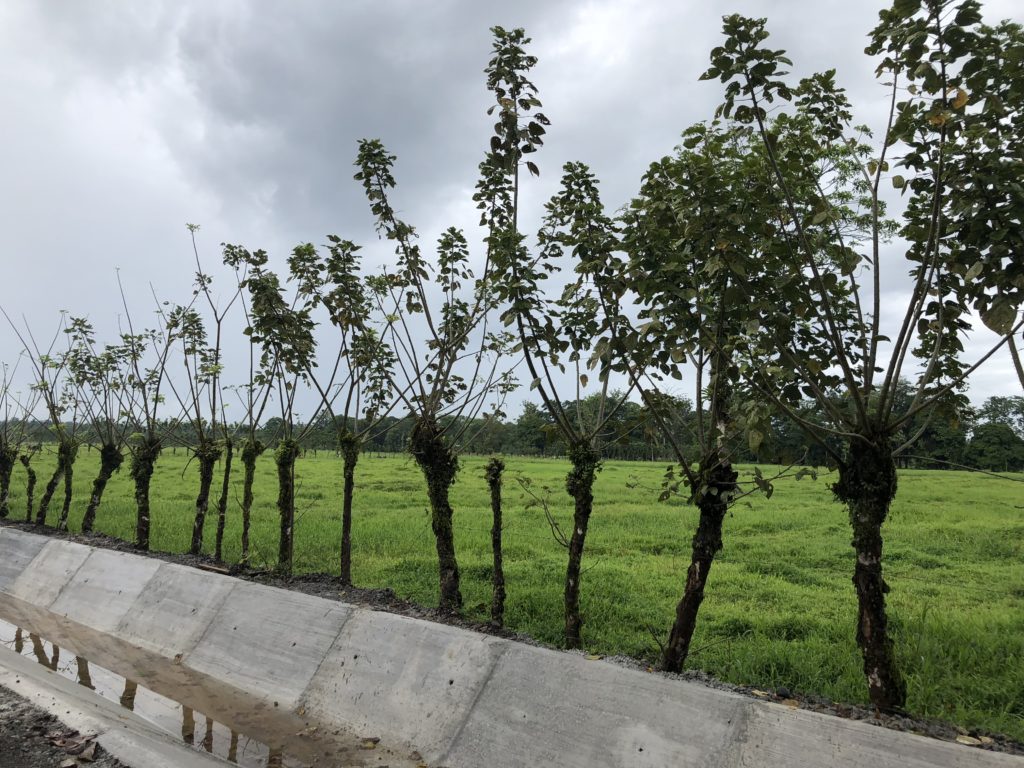
The waiting area at La Pavona.
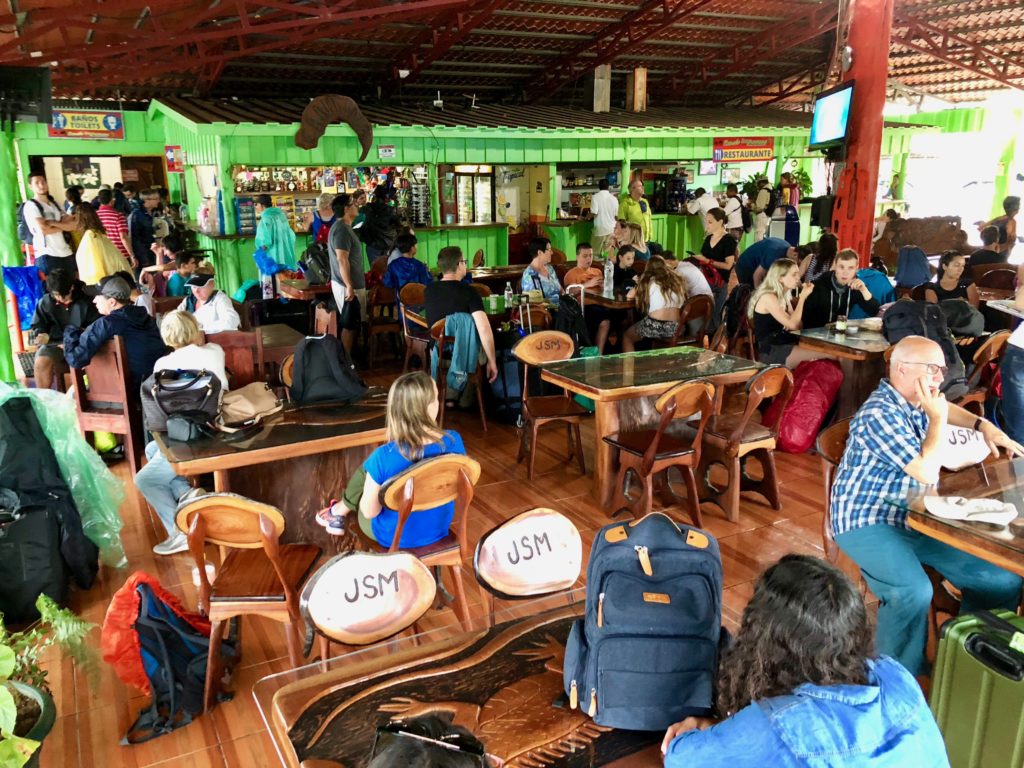
Our boat puttered along the Río la Suerte (Lucky River) until it merged with the Tortuguero River and ultimately fed into Penitencia Lagoon. Our lodge sat on the banks of the lagoon, accessible only by boat or plane. Across the water, another stretch of land provided views of dense foliage and macaws nesting in the tall tress, and just beyond those trees was the volcanic sand beach of the Caribbean Sea.
Our first afternoon at the lodge, we mostly pottered about, checking out the premises, reading our books in the terrace restaurant.
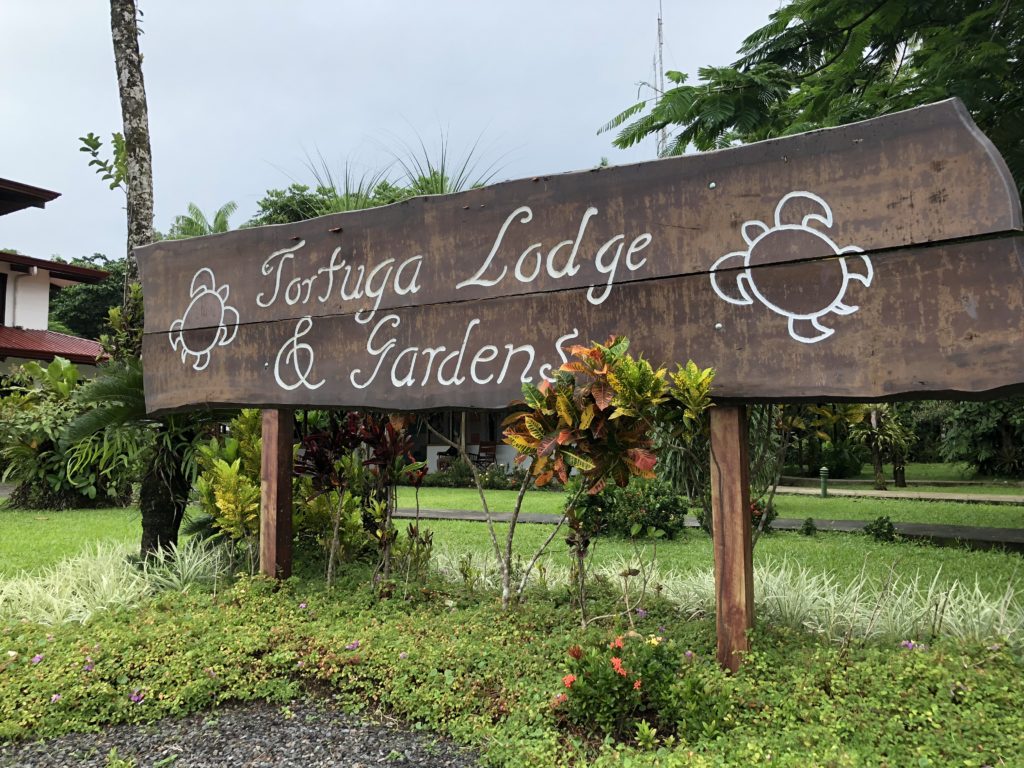
One of the guides pointed out a tiny leptodeira “cat-eye” snake, which was wound around the branches of a small bush.
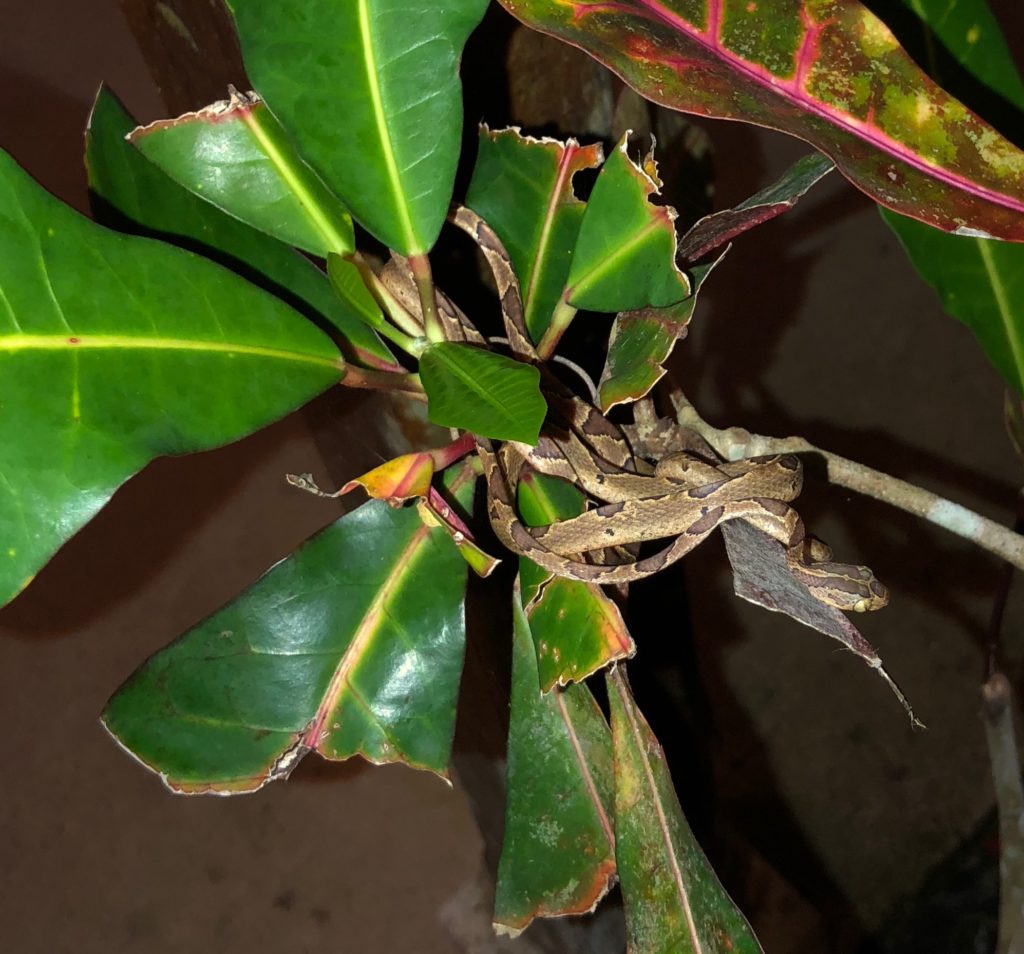
I became a bit obsessed with the montezuma oropendula bird, which builds suspended nests and has a gurgling call like an old-fashioned bicycle bell. This tall palm in front of the reception area featured many nests, including one uninhabited one for visitors to see up-close.
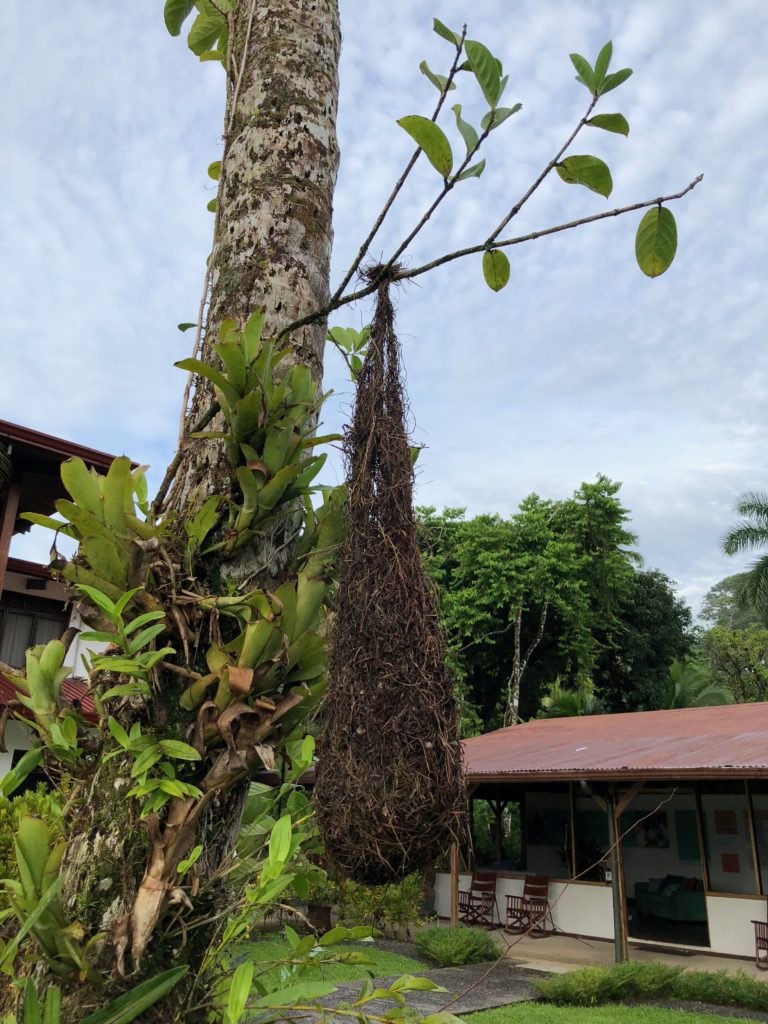
I’ve spent some time on the website BirdNote and learned that this cool bird is a colonial breeder, so the male (which is, by the way, twice the size of the female) maintains a little harem of ladies, who weave the incredible nests.
You would think that taking a plane to a city, then a car to the country, then a boat to a reclusive lodge would land you in the quietest place on earth. But, guess what? Nature is freakin’ loud! In a good way. The rooms at our lodge have open screened windows, so we felt like one with the rainforest. At bedtime, we could hear crashing waves, humming cicadas, chirping geckos, croaking frogs, occasional bird calls, and as the night wore on, it sounded like a freight train was about to crash into our room – rain. We lived in Laos and India, so I’m no stranger to monsoons. But this was a crazy amount of rain in a short amount of time. Around 4 a.m., I woke to a roaring animal in the garden behind our room. I would have thought it was a big cat dry heaving and hacking up a fur ball, but we had been warned about the howler monkeys. For much of the morning, they belted out their throaty howls, which can be heard for more than three miles. We loved it, but Tony pondered whether the locals ever dreamed of moving to the big city to escape the noise.
I chose gallo pinto for breakfast again and was not disappointed. Afterwards, we met up with Willis and a few other guests for a boat tour in the Tortuguera National Park. Before floating far from the lodge, Willis – with help from Tony, who has a superpower for spotting camouflaged critters – had already pointed out these attractions:
* a three-toed sloth,
* a two-toed sloth,
* a female anhinga (a water bird),
* a vulture,
* all three of the most common kingfishers in the area, including several Amazon and ringed kingfishers, and a tiny green kingfisher, which speared a fish and gobbled it up for our entertainment,
* many green macaws,
* howler monkeys, which looked exhausted from all that early morning howling and lounged lackadaisically with their prehensile tails wrapped around the branch for stability,
* collared aracari toucans, which have colorful bodies but plain beaks (unlike the Froot Loops mascot), and
* a boa constrictor that was about 4 feet long and so tangled up in a bush that we couldn’t find its face.
Unfortunately, I didn’t get any good photos. (a) Camouflage really works, and (b) these guys were not posers.
Here’s Willis, our guide. He said his great-grandfather came to Tortuguera to hunt turtles and other game. His grandfather followed suit, and his father also became a hunter until conservation became popular, and then he started working as a guide. Willis remembers riding in his dad’s boat and learning how to spot wildlife by sight, sound, and smell. He is the first generation not to carry a gun or knife, he said, and only to work in the interest of the ecosystem.
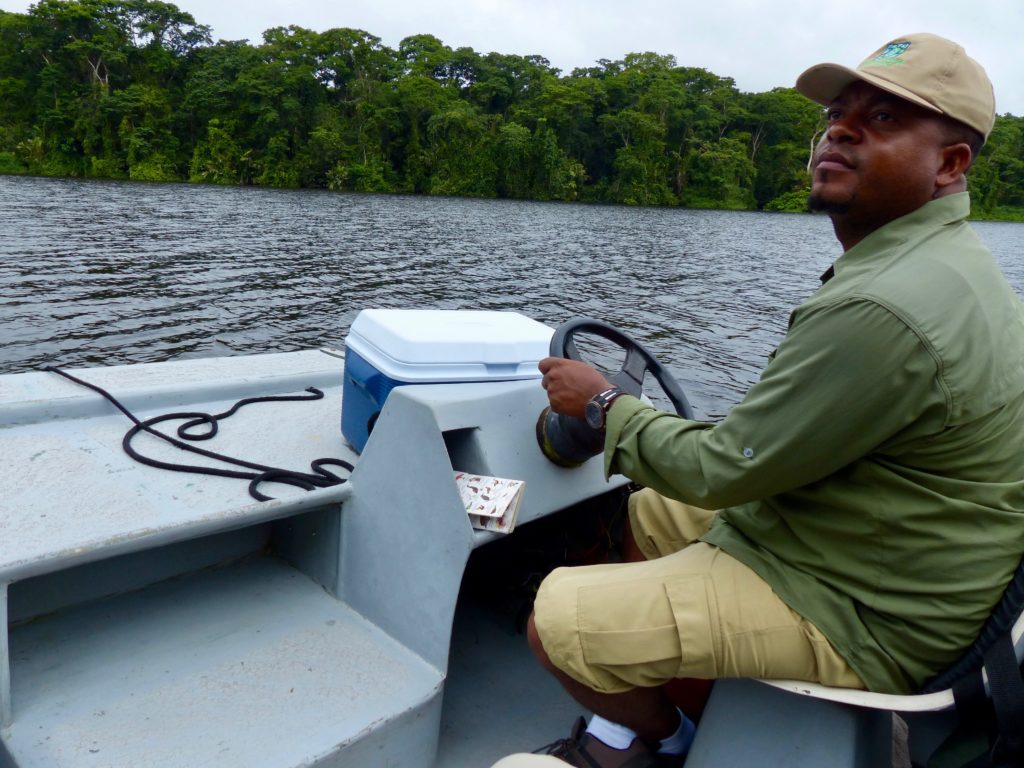
The nearly invisible tiger heron.
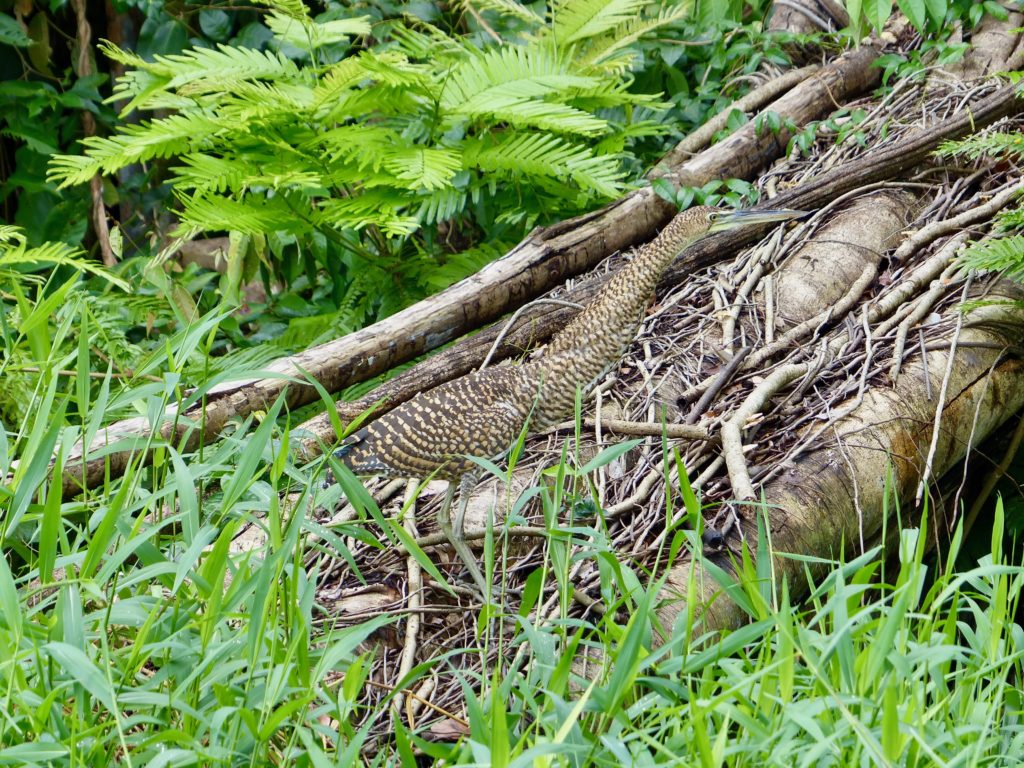
The wildlife extravaganza continued after our boat entered the national park. We saw:
* several bare-throated tiger herons,
* many blue morpho butterflies, which have wings that are brilliant iridescent blue when open and dull brown when closed,
* a male anhinga,
* two green herons,
* several white-faced capuchin monkeys,
* a few spider monkeys,
* a great curassow, which Willis called a turkey, hopping up a tree from branch to branch,
* two northern jacana birds foraging in the water lillies, and
* several caimans, a smaller cousin of the crocodile.
At one point, Willis spotted a Jesus Christ lizard. The bright green crested lizard got its name from its ability to run across water, something we got to see in action. Willis reached down out of the boat to splash water on the lizard, and it leapt off the stump and dashed across the water in to the jungle. At the same time, caiman #1 raised its head out of the water and settled mostly submerged and still.
After marveling at the caiman for awhile, we motored a short distance away to watch a white-faced capuchin monkey feeding in a tree. Suddenly, caiman #3 started swimming toward us. Tony saw him first and later said it looked like a cartoon, with only his eyes poking up out of the water as he drifted toward our boat. I couldn’t decide what to focus on: the monkey or the caiman! Eventually, the monkey swung out of view and the caiman found a sunny spot to rest, so we moved on.
Caiman #3 started swimming toward us at the same time this guy was jumping around in the branches of a tree.
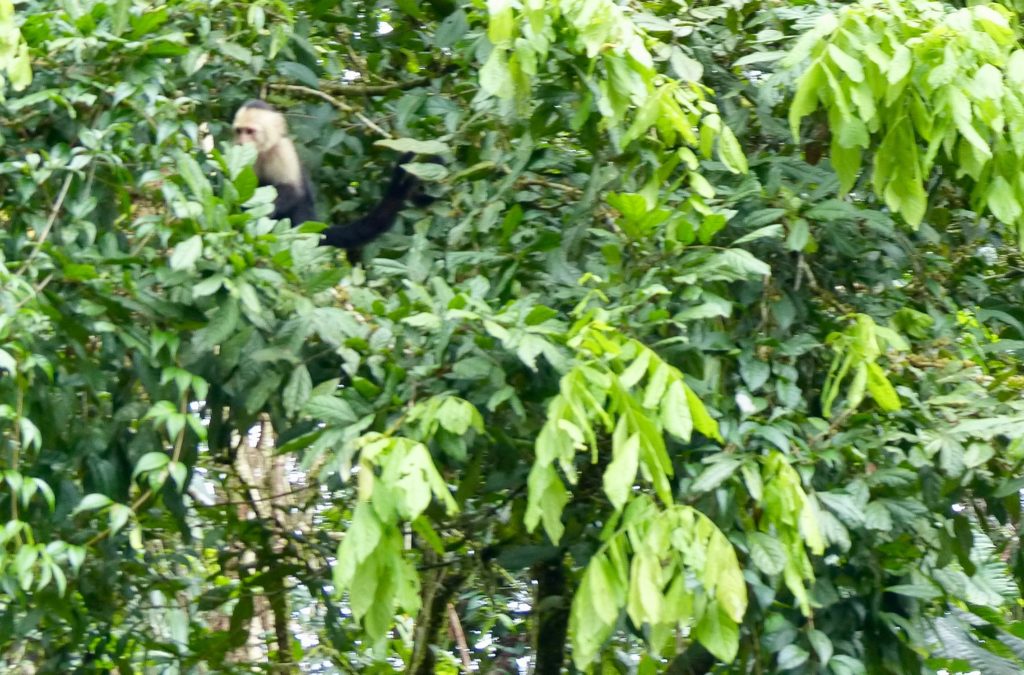
Many rainforest trees have incredible buttress roots.
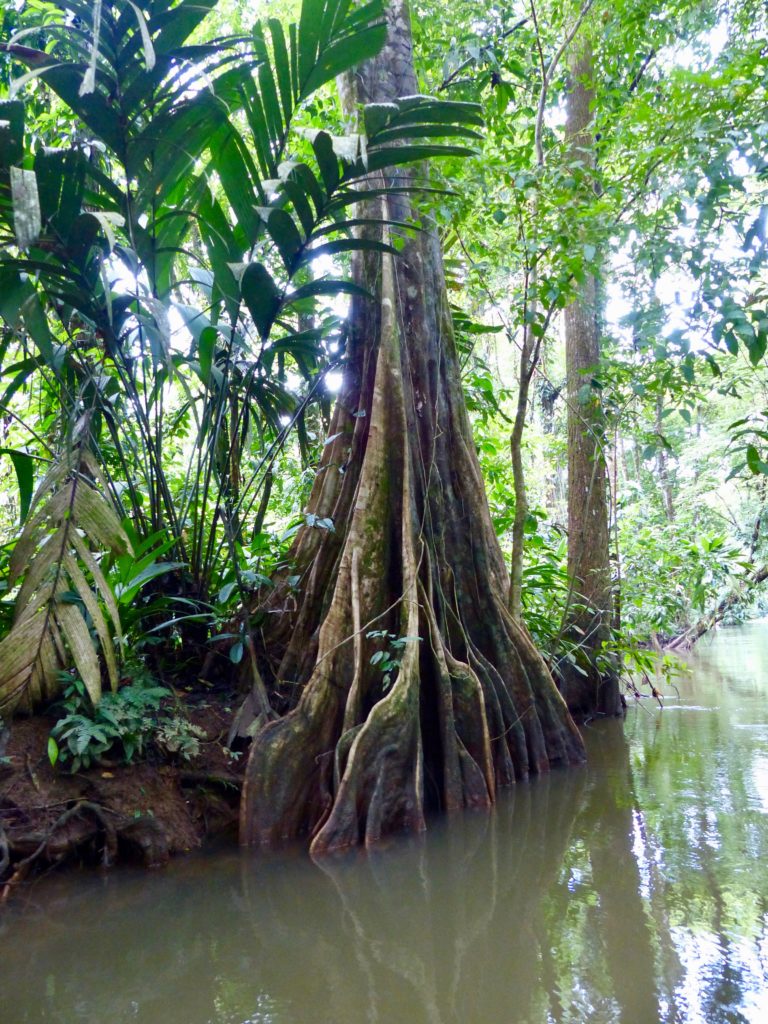
Pretty scenes from our boat trip.
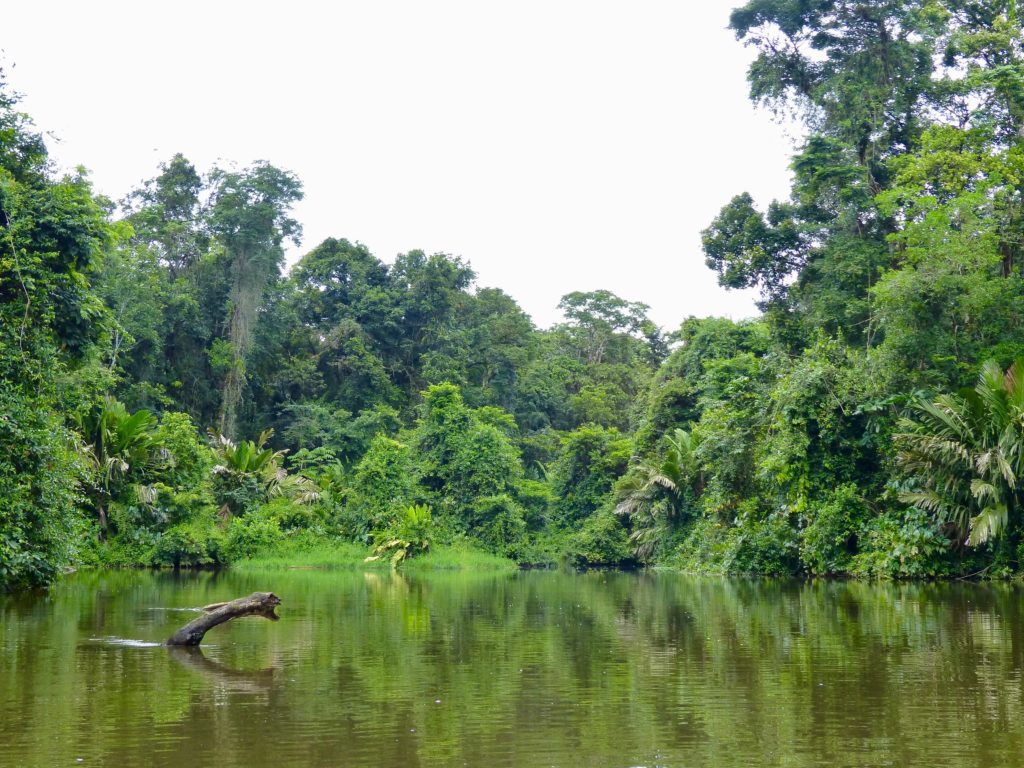
On the way back to the lodge, Willis took a detour to show us the nesting area for green sea turtles. According to Lonely Planet:
Female turtles return every two to three years to lay their eggs on the exact same beach where they were born. These behemoth animals average about 120 cm and weigh as much as 150 kg, so seeing one in person at such close range is a truly spectacular experience. Each female turtle lays eggs six times during the nesting season, and researchers discovered 18,000 nests along Tortuguero’s coast in 2015 alone.
Maybe we’ll return during nesting season some day.
Back at the lodge, we enjoyed a tasty lunch and then met up with Norton for a guided walk around the gardens. He took us to the southernmost point on the back of the property and set up a telescope, aimed at a tree across a small stream. “There was a sloth here earlier … oh good! He’s still here,” Norton said.
Sure enough, the two-toed sloth was hanging upside down and scratching his arms with his long curved claws. “Sloths have a lot of fleas,” Norton pointed out. I love the way the Costa Rica Experts website explains it:
The fur of a sloth is actually an entire ecosystem in and of itself with colonies of algae, fungi, moths, mites, and the like. The ecosystem serves as a sort of symbiotic relationship with the sloth as it gives them a green tint that allows them to hide from predators and also serves to make them rather unappetizing.
Sounds gross, but that sloth was freakin’ adorable. I could see his sweet little face plain as day as he slowly scratched his itchy armpits.
Norton walked around to a tree and pointed up. “Have you seen the bats?” he asked. I looked and looked and could not see them. “How can you not see them? There are 9, 10, 11, 12 of them,” Norton said, counting the invisible bats. Finally, Tony pointed out that they were lined up on the branch and blended in almost perfectly. Little bitty bats in a row. Norton noted they look like a snake when they sleep like that, and if they sense danger, they move along the branch one at a time to give the appearance of a slithering snake. How crazy is nature?!
Don’t worry … I won’t shame you if you can’t see the bats.
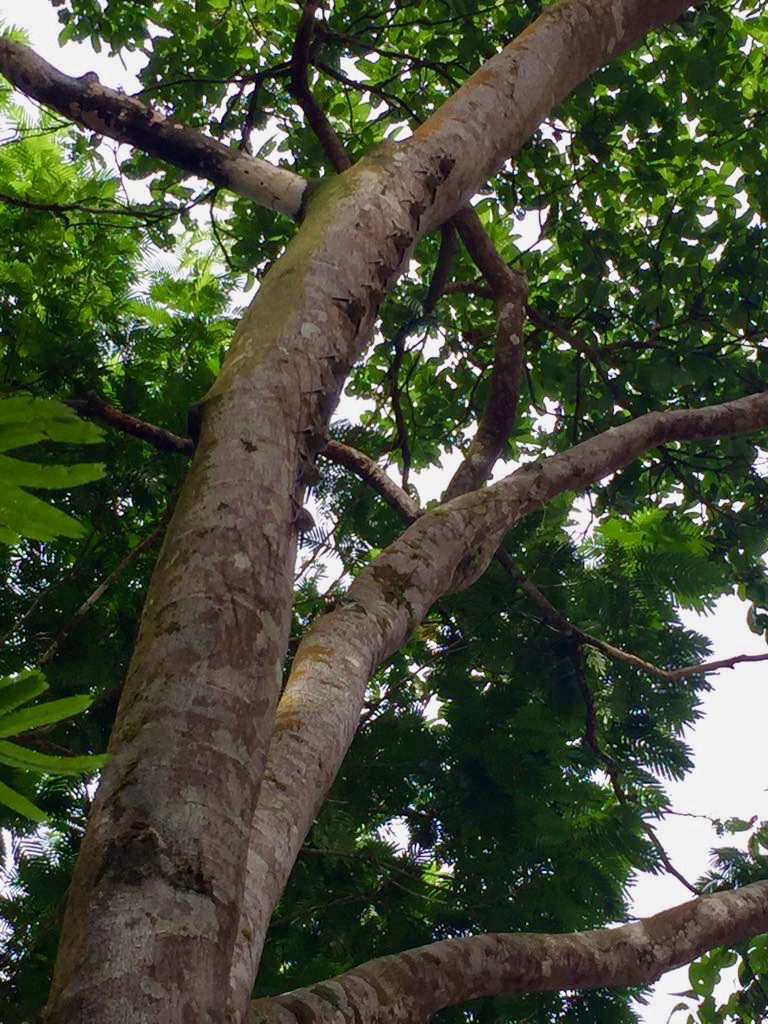
Next, we walked through the lodge’s back yard, learning about different plants and their medicinal value. Norton pointed out two bright red tiny tree frogs, a baby hummingbird in the smallest nest you ever saw, a ylang-ylang tree with blossoms that smell like heaven, and finally, he aimed his telescope across the lagoon to a tree full of green macaws. What a treat!
Hmmm… taking a photo with your phone of an image on a telescope does not work well. Plus, the dang macaws had mostly taken off by the time I got it to focus.
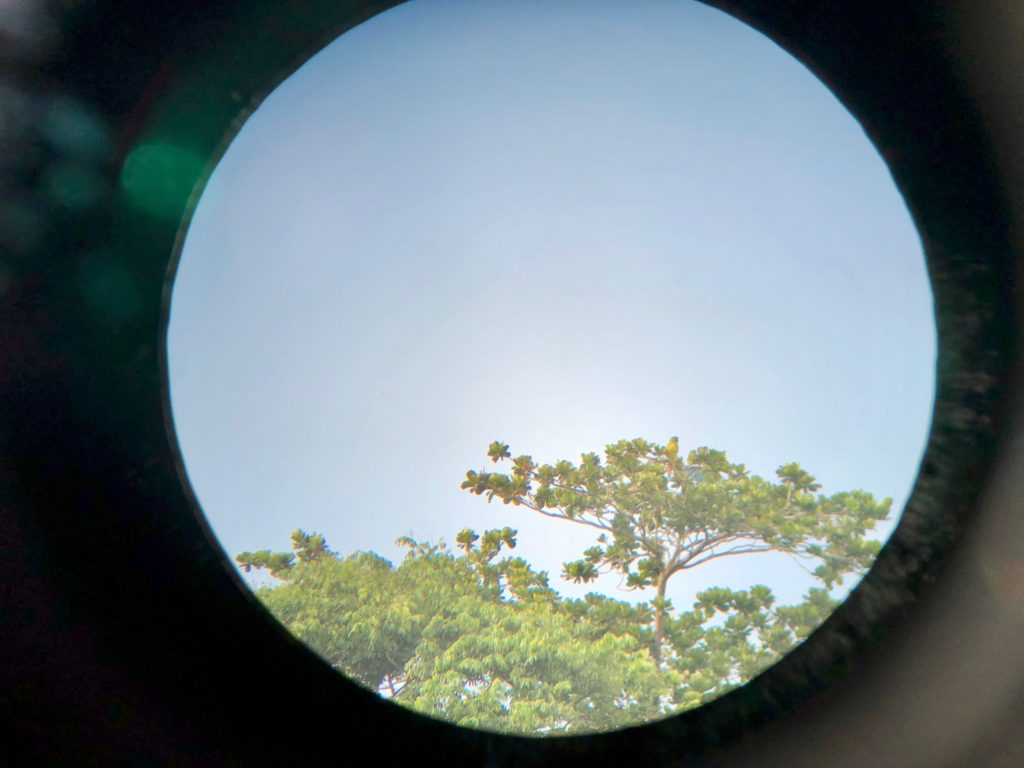
Tony poses with the “walking palm.” Can you say “Lord of the Rings”??? Norton explained that the palm follows the sun, so the “legs” dry up if they no longer support the tree, which gives the illusion that it’s walking.
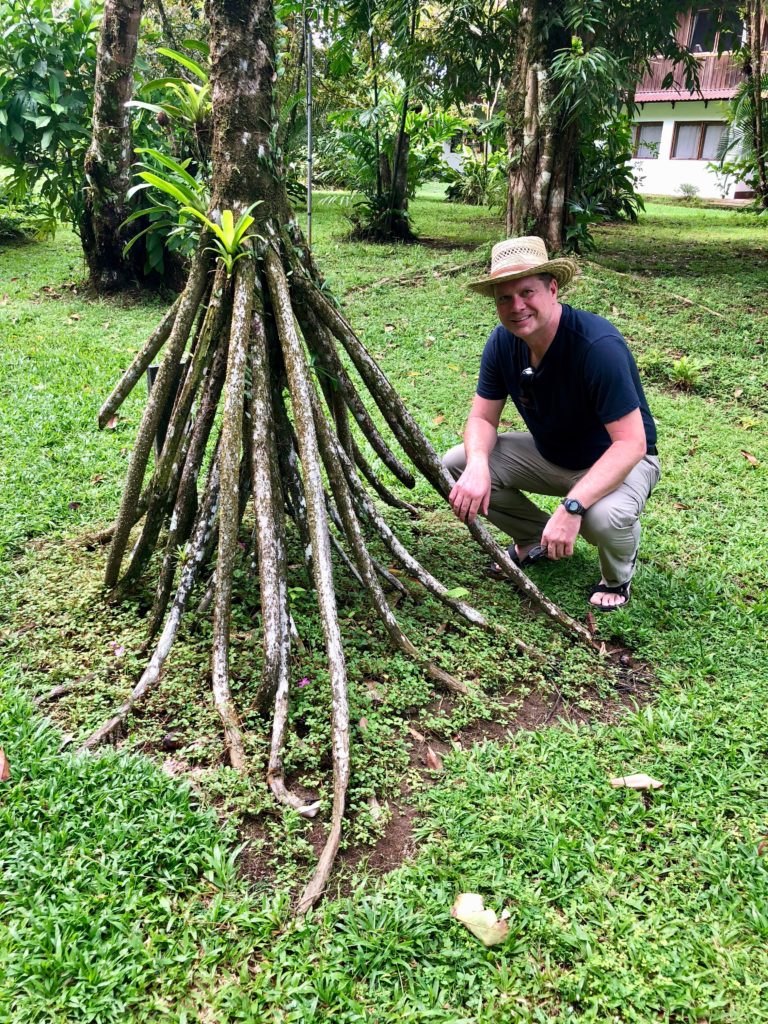
Because our visit here was cut short by Latam Airlines, every minute counted. So after our garden walk, we hitched a ride on the lodge’s water ferry to the beach across the lagoon. We climbed out of the boat, walked across the air strip (which felt a little dangerous), and through a break in the trees. The beach was completely deserted except for one other family from our hotel. I immediately kicked off my shoes and ran into the warm surf. We walked up the beach for about 30 minutes. I practiced a few yoga asanas while Tony poked around for shells. And in one magical moment, a huge flock of macaws buzzed our heads and swooped in a circle before landing on some beachfront trees.
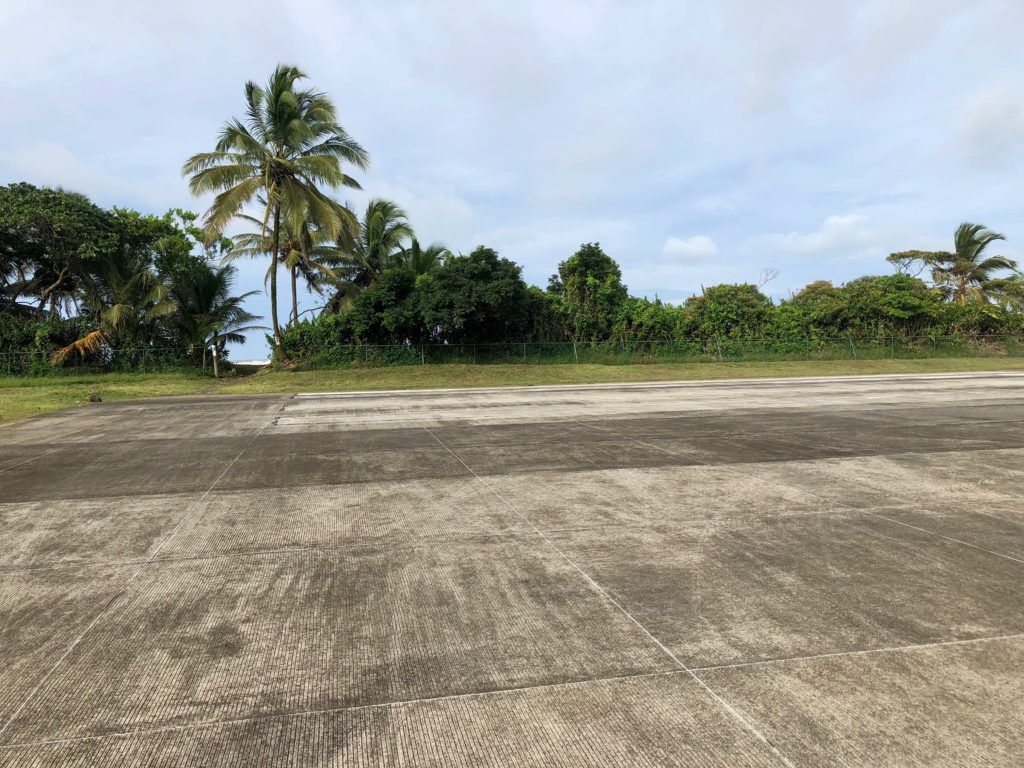
We had been warned about staying too long. That’s because the only way to get back to the lodge was to stand at the shore and wave your arms frantically until somebody saw you and sent a boat. They told us if we waited too long, it would get dark and they wouldn’t see us. Sure enough, someone spotted me gesticulating and came to get us.
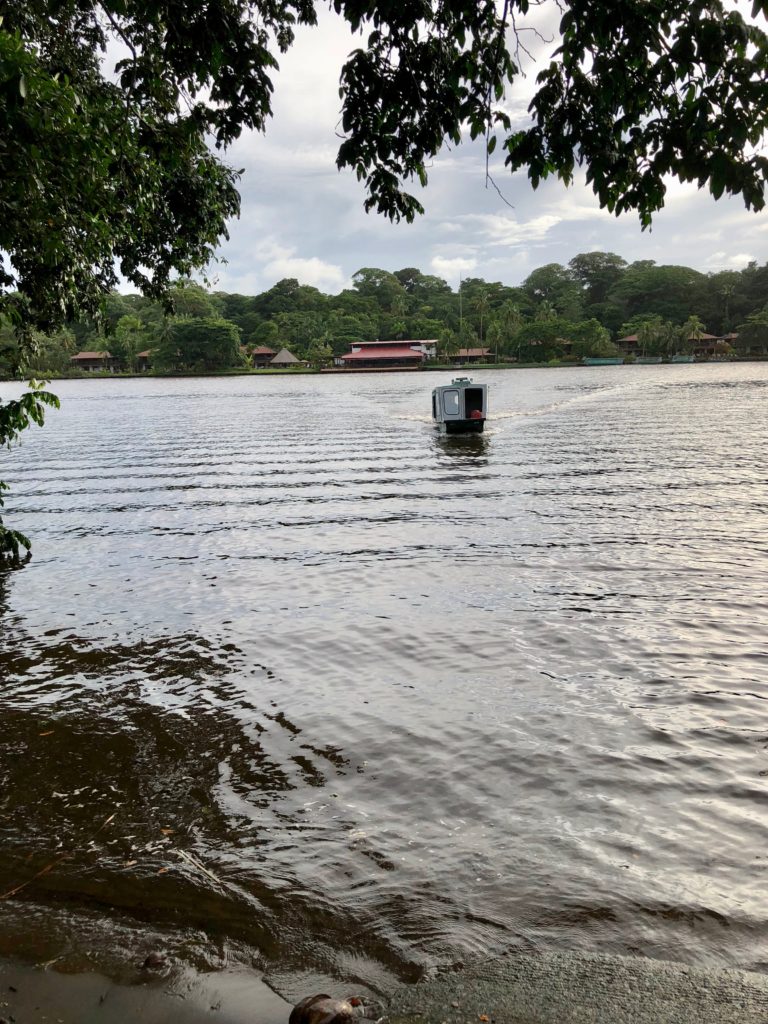
After a dip in the saltwater infinity pool, we hunkered down for a little break. Right on cue, the rains started up again. Perfect timing.
I can’t believe how much we did in one day. Tomorrow, we’re off to Fortuna. Stay tuned!

